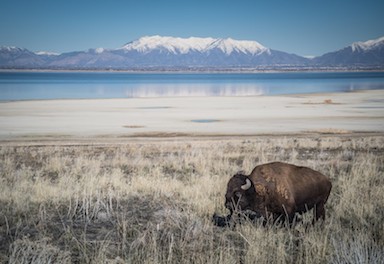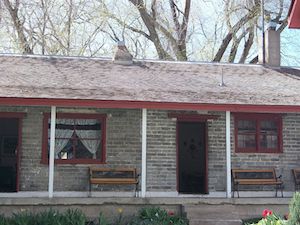Antelope Island
Antelope Island is in the Great Salt Lake and accessed through the city of Syracuse along a seven-mile causeway to the island. It is part of the Utah State Park system. Visitors can camp, hike, ride e-bikes, boat, swim, and watch wildlife (including bison, antelope, mule deer, coyote, and waterfowl). They can also tour the Fielding Garr Ranch, which was reopened to visitors in 2000.
History of the Island’s Inhabitants
Early Native Americans roamed the landscape over the past 6,000 years, leaving artifacts near the island’s 40 freshwater springs.[1] The Fremont people lived on the 42-square-mile island some 2,000 years ago. The Ute people frequently came to the island until the late 1840s.
John C. Fremont named the island in 1845. He had mapped the topography of the Great Salt Lake and its islands in 1843. The first party of Mormon pioneers arrived in the Salt Lake Valley in 1847, and by 1848, Heber P. Kimball, Lot Smith, and Fielding Garr brought cattle belonging to The Church of Jesus Christ of Latter-day Saints to the island.
Fielding Garr built a ranch house from 1848 to 1849 and was foreman of the tithing herd of cattle, in other words, members of the Church often paid tithing with animals and goods. After Garr’s death in 1855, others cared for the ranch and the cattle, including Bryant Stringham, William Ashby, and Ebenezer Farnes. The Church also cared for horses and a sheep herd on the island.
The Fielding Garr Ranch
Garr, a widower with nine children, was sent by the Church of Jesus Christ to live on the island and establish a ranch to manage the Church's tithing herds of cattle and sheep. The ranch was to also contribute to the Perpetual Emigration Fund. The first building was an adobe house built in 1848 by pioneers of European descent, and it is still in existence as the oldest building in Utah that still remains on its original foundation. The adobe ranch house was continuously inhabited until 1981. The Fielding Garr Ranch was listed on the National Register of Historic Places in 1983.
“The building of the Transcontinental Railroad in 1869 opened the rest of the island to settlement by homesteaders. The first federal surveys of the island revealed that only the area surrounding the Fielding Garr Ranch had been improved. This discovery gave the federal government the authority to open the island to settlement under the Homestead Act. Settlement on the island was unsuccessful and by 1900 most of the settlers had not improved their claims and, except for the ranch, the island was free of human habitation.”[2]
At times it was difficult to be isolated on the island. Those who cared for the Church herds left around 1875 because of homesteading and patents to the Union Pacific Railroad requiring every odd section of land. John Dooley Sr. bought the island for $1 million. Dooley focused on raising sheep. The Fielding Garr Ranch became one of the most industrialized and largest sheep ranching operations in the western United States until the 1950s when the wool market failed. Cattle was then brought to the island. By the time the state bought the ranch in 1981, it was one of Utah’s largest cattle operations.
In 1874, slate was mined from the island. Twelve bison were brought to the island in 1893 by Dooley. Four mountain sheep, some deer, and some Chinese and English pheasants, bighorn sheep, and pronghorn antelope were also reintroduced to the island.
In 1984, the ranch was sold to the State of Utah to go with 2,000 acres of the island that had been purchased by the state in 1969. Cattle and sheep were removed from the island. In 1926, A. H. Leonard bought the herd of bison but the water level and the boats available to him made it impossible to move them. The current herd of 550 to 700 American bison is one of the largest and oldest publicly owned bison herds in the nation.
Chronic low lake levels, however, have turned Antelope, as well as other islands in the lake, into peninsulas that potentially allow the bison and bighorn sheep to reach the mainland.[3]
Daddy Stump
Daddy Stump was first mentioned in 1848 as living on the island. He is credited with helping Kimball, Garr, and Smith with the cattle. Stump was probably a mountain man and had built a small cabin and had a small peach orchard on the island. “The LDS Improvement Era magazine from 1907 mentions Stump twice in its Vol. 10 contents in March and July. First, he is called an "old mountaineer." Secondly, several pioneers of The Church of Jesus Christ of Latter-day Saints reported that Stump’s rustic camp was located in a little canyon near a spring of water on the south end of the island. Stump is referred to as an ‘old trapper.’”[4] He may have left the island in 1849 after the Fielding Garr ranch was firmly established. It is believed that he was killed by Indians in Cache Valley during the winter of 1856. That year, Brigham Young visited the island and stopped by Stump’s cabin, claiming that "everything was found just as the old man had left it.”[5]
“Stump’s only remaining legacy is that a ridge on the south end of Antelope Island is honored with his name and that Antelope Island State Park periodically hosts a seasonal hike, called the “Daddy Stump History Tour.”[6]

